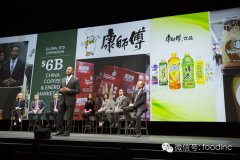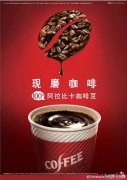Master Kang wants to work with Starbucks to make ready-to-drink coffee?
In a circular, the two sides announced today that they have signed a formal cooperation agreement to produce Chinese mainland ready-to-drink drinks and expand distribution channels in the local market. The circular described that the cooperation agreement will rely on the advantages of both sides, bring all Starbucks ready-to-drink product lines into the Chinese market, and strengthen the innovative ability of localization to meet the needs of Chinese customers.
Does China really need ready-to-drink coffee? China's ready-to-drink coffee and energy drinks market is worth $6 billion and is expected to grow by a further 20 per cent over the next three years, according to the two sides citing data from Euromonitor, a market research firm.
Let's take a closer look based on Euromonitor's figures. The size of ready-to-drink coffee in China just exceeded 200m litres in 2012, compared with 254 million litres last year, and is expected to grow to 345 million litres this year and 398 million litres in 2016.

In terms of market share, the top three in 2014 are Nestl é, Suntory and Unification. Their market share in China is 55.50%, 14.10% and 5.90%, respectively. The market also includes competitors such as Kirin, Wangwang, Wa and, of course, Starbucks, but its share is as low as 1.0%.
The shares of the first three giants are all close to 75%, and they are doing well. Snack Dai previously reported that in sharp contrast to the slowdown in the instant coffee category, Nestl é's ready-to-drink coffee achieved double-digit growth in China in 2014, said Bok Kai, CEO of Nestl é. The unification of the annual results just announced the day before yesterday indicated that it would accelerate the investment of resources and intensive cultivation of channels for first-and second-tier focus cities, so as to expand the relative competitive advantage of ready-to-drink coffee.
However, Master Kang and Starbucks still want a piece of the pie. Today, in the above announcement, Starbucks said that this cooperation will promote Starbucks to develop new product categories, while Master Kang said that the ready-to-drink market has a broad space for development in China, and the cooperation with Starbucks will further enrich Master Kang's beverage portfolio in the Chinese market.
The two families have made a clear division of labor. Under the agreement, Chinese mainland will give full play to its expertise and leadership in coffee, responsible for product development and innovation, as well as brand development, while Master Kang will be responsible for the production and sale of Starbucks ready-to-drink beverages in Starbucks.
The announcement did not also disclose how long the agreement will last, but said it plans to produce and market Starbucks bottled Frappuccino drinks with existing and new flavors in China in 2016. After that, more innovative products will be launched. Starbucks ready-to-drink products will be extended to more sales outlets and cities.
According to the company's quarterly report last year, as of that time, the company had 35870 dealers in Chinese mainland, 118635 direct retailers and 452 beverage production lines. As for Chinese mainland, it has more than 1500 stores, and ready-to-drink coffee is now available in more than 6000 stores, supermarkets and convenience stores. Tmall supermarket shows that Frappuccino is currently imported from the United States, a bottle (281ml) "special price" about 15 yuan.
In fact, Chinese mainland launched its own ready-to-drink coffee for the first time in 2007, in partnership with Pepsi, when the former focused on the latter's distribution capabilities. However, about three years later, Pepsi accepted Suntory's offer to help it distribute ready-to-drink coffee. A source told the snack generation at that time that this was tantamount to announcing a "breakup" with Starbucks.
Later, Pepsi Beverage and Master Kang later formed an alliance. Today, Starbucks is back.
Multinationals tend to look for a local partner on Chinese mainland because it is the easiest way to target consumers in China's huge market, Reuters reported today. The report also quoted analysts as saying that the cooperation will reduce the cost of Starbucks ready-to-drink coffee and allow Starbucks products to appear in some small Chinese cities, which will create a new group of customers for it.
Important Notice :
前街咖啡 FrontStreet Coffee has moved to new addredd:
FrontStreet Coffee Address: 315,Donghua East Road,GuangZhou
Tel:020 38364473
- Prev

Starbucks shareholders' meeting on China: store opening, on-site baking, Master Kang and Tea Brand conversion
The annual shareholders' meeting of Starbucks was solemnly held! Shareholder representatives from the United States and around the world are jubilant, tearful and worshiped to hear how Starbucks executives, centered around chairman and CEO Howard Schultz, turn brown coffee into green dollars. You can ignore the above rumors, but this stock market
- Next

KFC starts selling freshly ground coffee, focusing on cost-effective
Among the six coffee products, the cheapest American coffee costs 10 yuan per cup, while the most expensive mocha costs 19 yuan much lower than Starbucks'30 yuan level. Compared with McDonald's, KFC's coffee price does have an advantage. McDonald's McCoffee has the cheapest small cappuccino of 12 yuan, most of the medium cup 13 to 19 yuan, and the large cup more than 20 yuan. Blog comments: @ Hermann China Retail Weibo: I
Related
- Why can American refills for free? The difference between Americano and American drip pot coffee
- Being chased out of the rain in front of Starbucks?! Store: Sheltering from rain under umbrellas poses a safety hazard
- The white moonlight has changed?! Lucky launches "Big Winter Pear American"
- Hand-brewed coffee three-stage method, high-sweet and universal brewing method to share! What does the high sweet water level of hand-brewed coffee mean?
- What is the difference between raw, refined and full espresso coffee? How to extract espresso and taste good?
- A complete list of coffee bean names and their meanings! What is Yejia Shefi coffee? Where is Mantelin coffee?
- What grade does Arida Manor Kaduai coffee beans belong to? What treatment is Arida ASD slow anaerobic sun exposure?
- The milk tea cup becomes smaller?! Overlord Tea Girl launches a new "Return to Yunnan" series
- Accused of selling counterfeit and high-priced coffee beans! Well-known boutique coffee brand "Oukelao" bowed and apologized!
- How to make espresso dumplings? Can I eat coffee and glutinous rice balls together?

